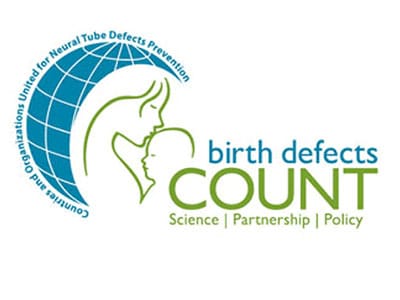CDC’s Articles on U.S. Folic Acid Intake, Fortification, and Neural Tube Defects

Key Findings: Daily Multivitamin Use among Women of Reproductive Age Declines
The Journal of Women’s Health published a study that examined the daily multivitamin use among women of reproductive age.
Key Findings: Are Women Getting Enough Folic Acid?
The American Journal of Clinical Nutrition published a study that shows that some U.S. women are still not getting enough folic acid in their diets to lower the risk of a neural tube defect.
Key Findings: Improving Healthcare Counseling among Hispanic Women before They Become Pregnant
The Journal of Women’s Health published a study that looked at healthcare counseling among Hispanic women on taking folic acid before and during pregnancy and medicine use during pregnancy.
Key Findings: The Promotora de Salud Model Promotes Positive Health Behavior Change
The Journal of Women’s Health has published a study examining the use of the Promotora de Salud model for folic acid education in Hispanic communities.
Key Findings: Blood Folate Concentrations and Risk of Neural Tube Defect-Affected Pregnancies: Where Does the United States Stand?
Birth Defects Research Part A published a study that looked at the amount of folate in the blood (blood folate concentrations) among women in the United States in relation to their risk of having a baby affected by a neural tube defect.
Key Findings: Folic Acid Fortification
CDC’s Morbidity and Mortality Weekly Report published a study that shows folic acid fortification in the United States continues to prevent neural tube defects.
Key Findings: Folic Acid Use among Pregnant Women Who Have Had a Past Pregnancy Affected by a Neural Tube Defect
CDC’s Morbidity and Mortality Weekly Report published a study looking at folic acid use before pregnancy in women who have had a previous pregnancy affected by a neural tube defect.
Key Findings: Fortification of Corn Masa Flour with Folic Acid in the United States
The journal Annals of the New York Academy of Sciences published an article about the fortification of corn masa flour with folic acid in the United States and how it can improve health outcomes for Hispanics.
Key Findings: Lack of Vitamins Containing Folic Acid and Diabetes-Associated Birth Defects
The American Journal of Obstetrics and Gynecology published a CDC study: “Lack of Periconceptional Vitamins or Supplements That Contain Folic Acid and Diabetes Mellitus-Associated Birth Defects.”
Folic Acid: The Best Tool to Prevent Neural Tube Defects
Learn how to get healthy before and during pregnancy to increase your chances of having a healthy baby. Plan ahead by getting 400 micrograms (mcg) of folic acid each day.
Women Need 400 micrograms of Folic Acid Every Day
CDC urges every woman who could become pregnant to get 400 micrograms (400 mcg) of folic acid every day.
World Birth Defects Day
March 3rd is World Birth Defects Day, which aims to raise awareness of birth defects, their causes, and their impact around the world. Every year, about 3–6% of infants worldwide are born with a serious birth defect. This means that life-altering conditions like spina bifida and congenital heart defects affect millions of babies and families.
Impact of voluntary folic acid fortification of corn masa flour on RBC Folate concentrations in the U.S. (NHANES 2011–2018)
Nutrients. 2021; 13(4):1325
Wang A, Rose CE, QI YP, et al.
[Read article]
Lack of historical evidence to support folic acid exacerbation of the neuropathy caused by vitamin B12 deficiency
Am J Clin Nutr. June 2019.
Berry, RJ.
[Read article]
One-carbon cofactor intake and neural tube defect risk among women meeting folic acid recommendations: A multi-center case-control study
Am J Epidemiol. June 2019;188(6):1136−1143.
Petersen JM, Parker SE, Crider KS, Tinker SC, Mitchell AA, Werler MM.
[Read article]
Systematic review and Bayesian meta-analysis of the dose-response relationship between folic acid intake and changes in blood folate concentrations
Nutrients. January 2019;11(1).
Crider KS, Devine O, Qi YP, Yeung LF, Sekkarie A, Zaganjor I, Wong E, Rose CE, Berry RJ.
[Read article]
Trends in multivitamin use among women of reproductive age: United States, 2006–2016
J Womens Health (Larchmt). January 2019;28(1):37−45.
Wong EC, Rose CE, Flores AL, Yeung, LF.
[Read article] [Read Key Findings]
Defining the plasma folate concentration associated with the red blood cell folate concentration threshold for optimal neural tube defects prevention: a population-based, randomized trial of folic acid supplementation
Am J Clin Nutr. May 2019.
Chen MY, Rose CE, Qi YP, Williams JL, Yeung LF, Berry RJ, Hao L, Cannon MJ, Crider KS.
[Read article]
Global folate status in women of reproductive age: A systematic review with emphasis on methodological issues
Ann N Y Acad Sci. September 2018;1431(1):35−57.
Rogers LM, Cordero AM, Pfeiffer CM, Hausman DB, Tsang BL, De-Regil LM, Rosenthal, J, Razzaghi H, Wong EC, Weakland AP, Bailey, LB.
[Read article]
Development and utility of a birth defects surveillance toolkit
J Glob Health Perspect. June 2018.
Flores AL, Turay K, Valencia D, Hillard CL, Sekkarie A, Zaganjor I, Williams J, Qi YP, Cordero AM, Mulinare J, Botto LD, Peña-Rosas JP, Groisman B, Mastroiacovo P.
[Read article]
Modeling the impact of folic acid fortification and supplementation on red blood cell folate concentrations and predicted neural tube defect risk in the United States: Have we reached optimal prevention?
Am J Clin Nutr. June 2018;107(6):1027−1034.
Crider KS, Qi YP, Devine O, Tinker SC, Berry RJ.
[Read article] [Read Key Findings]
Discussing appropriate medication use and multivitamin intake with a healthcare provider: An examination of two elements of preconception care among Latinas
J Womens Health (Larchmt). March 2018;27(3):348−358.
Interrante JD and Flores AL.
[Read article] [Read Key Findings]
Folate deficiency is prevalent in women of childbearing age in Belize and is negatively affected by coexisting vitamin B-12 deficiency: Belize National Micronutrient Survey 2011
J Nutr. June 2017;147(6):1183−1193.
Rosenthal J, Largaespada N, Bailey LB, Cannon M, Alverson CJ, Ortiz D, Kauwell G, Sniezek J, Figueroa R, Daly R, Allen P.
[Read article]
Trends and characteristics of fetal and neonatal mortality due to congenital anomalies, Colombia, 1999-2009
J Matern Fetal Neonatal Med. May 2017;31(13):1748−1755.
Roncancio CP, Misnaza SP, Peña IC, Prieto FE, Cannon MJ, Valencia D.
[Read article]
Folic acid education for Hispanic women: The Promotora de Salud model
J Womens Health (Larchmt). February 2017;26(2):186−194.
Flores AL, Isenburg J, Hillard CL, deRosset L, Colen L, Bush T, Mai CT.
[Read article] [Read Key Findings]
Applying inappropriate cutoffs leads to misinterpretation of folate status in the US population
Am J Clin Nutr. December 2016;104(6):1607−1615.
Pfeiffer CM, Sternberg MR, Hamner HC, Crider KS, Lacher DA, Rogers LM, Bailey RL, Yetley EA.
[Read article]
Retrospective assessment of cost savings from prevention: Folic acid fortification and spina bifida in the U.S.
Am J Prev Med. May 2016;50(5 Suppl 1):S74−s80.
Grosse SD, Berry RJ, Tilford JM, Kucik JE, Waitzman NJ.
[Read article] [Read Key Findings]
U.S. women of childbearing age who are at possible increased risk of a neural tube defect-affected pregnancy due to suboptimal red blood cell folate concentrations, National Health and Nutrition Examination Survey 2007 to 2012
Birth Defects Res A Clin Mol Teratol. April 2015;103(6):517−526.
Tinker SC, Hamner HC, Qi YP, Crider KS.
[Read article] [Read Key Findings]
Assessing the association between the methylenetetrahydrofolate reductase (MTHFR) 677C>T polymorphism and blood folate concentrations: A systematic review and meta-analysis of trials and observational studies
Am J Clin Nutr. March 2015;101(6):1286−1294.
Tsang BL, Devine OJ, Cordero AM, Marchetta CM, Mulinare J, Mersereau P, Guo J, Qi YP, Berry RJ, Rosenthal J,
Crider KS, Hamner HC.
[Read article]
Updated estimates of neural tube defects prevented by mandatory folic acid fortification – United States, 1995–2011
MMWR Morb Mortal Wkly Rep. January 2015;64(1):1−5.
Williams J, Mai CT, Mulinare J, Isenburg J, Flood TJ, Ethen M, Frohnert B, Kirby RS.
[Read article] [Read Key Findings]
Supplement use and other characteristics among pregnant women with a previous pregnancy affected by a neural tube defect – United States, 1997–2009
MMWR Morb Mortal Wkly Rep. January 2015;64(1):6−9.
Arth A, Tinker S, Moore C, Canfield M, Agopian AJ, Reefhuis J.
[Read article] [Read Key Findings]
Prevention of neural tube defects with folic acid in China. China–U.S. Collaborative Project for Neural Tube Defect Prevention
N Engl J Med. December 1999;341(20):1485−1490.
Berry RJ, Li Z, Erickson JD, Li S, Moore CA, Want H, Mulinare J, Zhao P, Wong LY, Gindler J, Hong SX, Correa A, Hao L, Gunter E.
[Read article]
Recommendations for use of folic acid to reduce number of spina bifida cases and other neural tube defects
MMWR Morb Mortal Wkly Rep. September 1992;41(Rr-14):1−7.
Centers for Disease Control and Prevention
[Read article]
Effectiveness in disease and injury prevention use of folic acid for prevention of spina bifida and other neural tube defects—1983-1991
MMWR Morb Mortal Wkly Rep. August 1991;40(30):513−516.
Centers for Disease Control and Prevention
[Read article]
Prevention of neural tube defects: Results of the Medical Research Council Vitamin Study. MRC Vitamin Study Research Group
Lancet. July 1991;338(8760):131−137.
[Read article]

